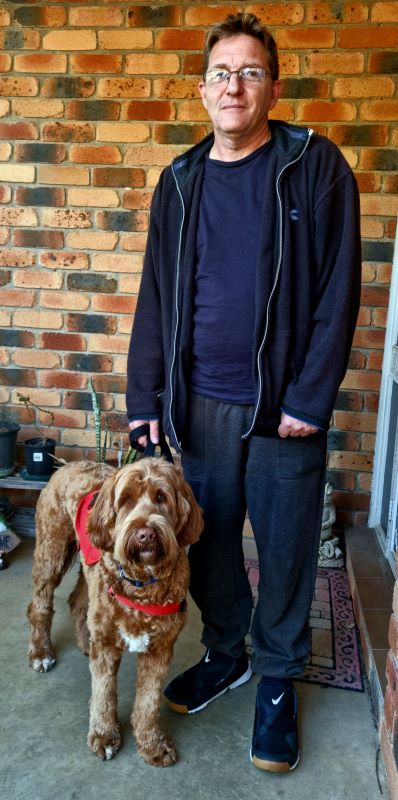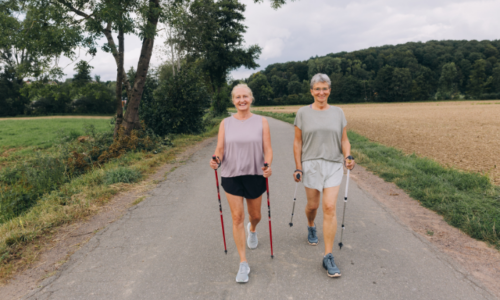My [Parkinson’s] Life Update:
Graham Saxby and his assistance dog Archer
Just over three years ago Graham Saxby shared his life story with the Parkinson’s NSW team.
His story included his career in hospitality and his volunteer work as a swimming instructor in the summer months, with about half the students having learning or physical limitations. He was also busy raising his two daughters after his marriage broke down.
Graham had been diagnosed with Parkinson’s six years before, but he had continued employment until the COVID-19 lockdown put paid to many jobs.
When we first talked with Graham, he explained he’d decided to apply for a special assistance dog to prepare for the time when he would be living alone with his condition deteriorating. Now he explains why it took so long to be approved for a special assistance dog – along with changes to his house to help with his disabilities.
“Back then I had attended a Parkinson’s support group meeting where an assistance dog trainer attended with their dog, to give a talk on how dogs can assist people with particular issues,” recalls Graham. “I was trying to plan for when my children leave home, and I knew that pets are good for a number of reasons.
“An assistance dog would also be able to help me in certain ways as my condition deteriorated and would keep me motivated to get out and get exercise and talk to people each day, as well as providing company.”
Beginning the application process
Graham duly put in an application through the NDIS process, filing the appropriate forms and lengthy reports from his occupational therapist, his clinical neuropsychologist, his neurologist, and other healthcare supports – as well as gaining acceptance of an application to the dog trainer.
“COVID interrupted the process but once it was put in, it was declined,” says Graham. “There were no formal reasons why and a new NDIS plan was just sent in the mail.”
Graham was shocked but followed up with an updated round of reports from all of those involved with his healthcare, and it was again declined.
“At the next AAT conference, I was asked to see an ‘independent’ neurologist by the NDIA. This was altered at the last minute to a review of only my medical records provided by the NDIA. So without full and up to date records, physically seeing me, a video conference or a phone call, the short report supplied by this professional questioned my diagnosis. Which meant it also questioned eight years of treatment, the competency of my treating health professionals, the value of support groups and finally the benefits that an assistance animal would provide me.
“That did my head in for a significant amount of time. I went from seeing my psychologist every few months to seeing them once a fortnight. I had to get more information to refute it with a specialist, physiotherapist, a dog trainer, and other things progressing on from there. It took quite a while, and it was still being refused by the NDIA. I ended up with a couple of thousand pages of documentation in this application and appeal process.”
In February this year Graham applied to have a review by an Independent Expert Review (IER) panel which had become available through the new Labor Federal Government.
“By April I had an acceptance and acknowledgement of all recommendations by the NDIA of the IER report,” says Graham. “After all the work, time, and delays before which took years, this review only took six weeks. During those three years I’d had my name down for three different dogs, two of which had finished their training and been placed with other people while I was still awaiting approval.”
 Graham and Archer together at last
Graham and Archer together at last
The third dog, a Labradoodle named Archer, has recently finished general training, and Graham and Archer are now getting settled in his newly modified house.
“He’s 20 months old,” says Graham. “We are working on him being able to do particular things like put certain items on a bench, pick up things, pull my socks off for me. They are specific tasks to help with my symptoms.
“An important one is that he does tactile prompting to get me out of reactive freezing – when I can’t move without tactile stimulus. We have bonded so well together, and he is giving me confidence to go out again to places with him, that I had found too difficult on my own.
“We are training together so I can be confident he can do things with me which will help me, aside from encouraging me to go out. It also means I can be independent and go out when and where I want to, without needing anyone else to come with me.”
Graham’s house modifications included new slip-resistant floorings, a wet-room bathroom, widened doorways, changed tap fittings, new electric locks, improved lighting and replacement of worn manual roller shutters to help regulate heat retention and cooling.
His older daughter and her companion cavoodle moved back with her mother during the renovations and they hope to find her independent accommodation to assist her to independence as she lives with autism.
His younger daughter is doing her HSC this year.
“She is studying animal care as part of her HSC studies,” says Graham. “She loves dogs, so Archer fits right in.”
Planning for the future is something Graham continues to do proactively.
“I’ve also followed through with looking at medications and trialled Duodopa,” he says. “It’s the new in-clinic model instead of having to go into hospital, which is easier. That’s another known pathway going forward now.
“I want to do as much preparation for my future as I can while I have the capabilities. Having my house modified and having Archer able to keep me independent is so important for me. Getting things in place is vital before you’re unsafe.”
Meanwhile Graham plans to continue to work on fundraising for Parkinson’s NSW and looks forward to taking Archer to his support group, and explaining to others how an assistance dog could help them.









